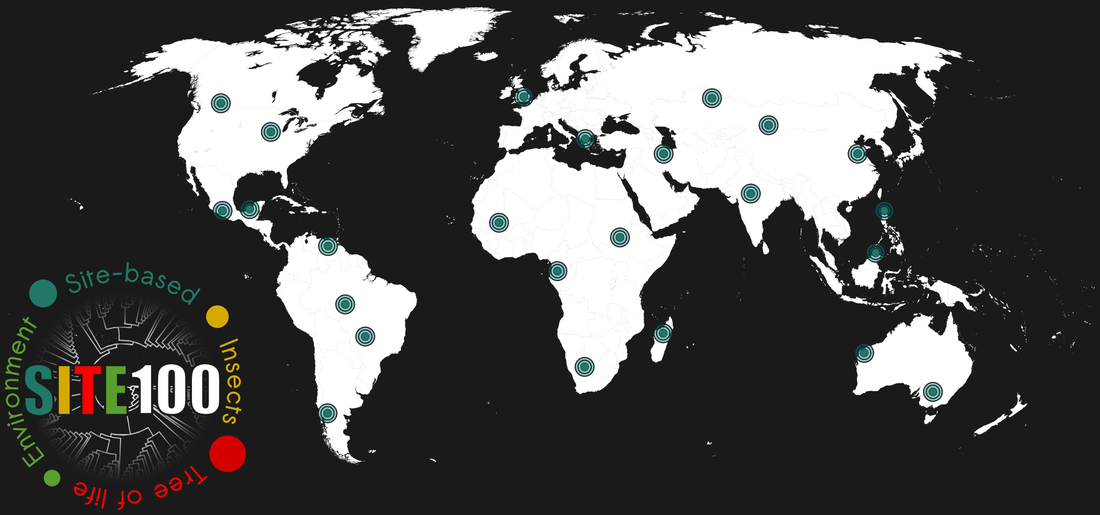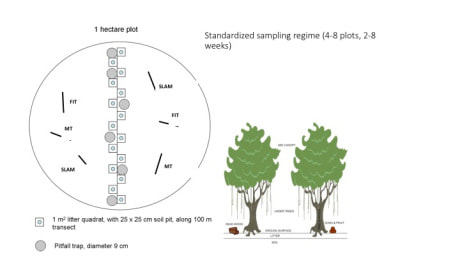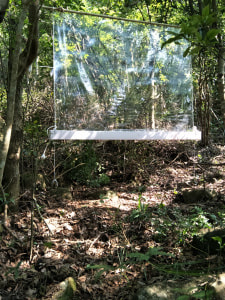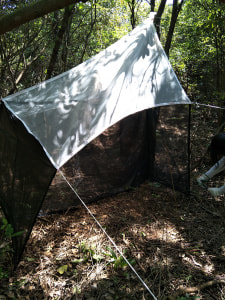FIELD PROTOCOLS
|
Sampling plots
SITE100 employs standardised plot-based sampling, using a set of trap types and numbers employed on plots of 1-ha. At a minimum each plot is sampled with standardised numbers of traps, including flight interception traps (FIT) (2 per plot), pitfall traps (a transect of 10 traps at 10 m distance), Malaise traps (MT) (2 per plot). In addition, other sampling types are used, as appropriate to individual studies. This includes sweeping of vegetation, light trapping at night, insecticide fogging, SLAM (suspended land and air malaise) traps, and deep-soil extractions using Berlese traps. |
Sampling regime and timing
The plot-based design is highly modular and can be applied in accordance with local research objectives and available resources. Multiple plots (4-8 plots) within a narrow locality (1 km2) are desirable and should be set up in a spatial design that reflects various distances of plots. A minimum sampling period of two weeks is recommended, although longer studies reflecting seasonal variation is desirable. Passive traps need to be emptied twice a week to ensure the preservation of specimens for DNA analysis.
Specimen preservation
DNA-grade specimens require rapid preservation in Ethanol. Ideally the traps use 96% ethanol as preservation fluid but due to high rates of evaporation, except in the case of Malaise traps. Alternative preservation fluids are polyethylene glycol or SDS-EDTA (see SDS+EDTA). If no other choice is available, car antifreeze may be used. In all cases, specimens should be transferred to 96% ethanol as quickly as possible and kept in a freezer at -20C until DNA extraction.
The basic trap types used
The plot-based design is highly modular and can be applied in accordance with local research objectives and available resources. Multiple plots (4-8 plots) within a narrow locality (1 km2) are desirable and should be set up in a spatial design that reflects various distances of plots. A minimum sampling period of two weeks is recommended, although longer studies reflecting seasonal variation is desirable. Passive traps need to be emptied twice a week to ensure the preservation of specimens for DNA analysis.
Specimen preservation
DNA-grade specimens require rapid preservation in Ethanol. Ideally the traps use 96% ethanol as preservation fluid but due to high rates of evaporation, except in the case of Malaise traps. Alternative preservation fluids are polyethylene glycol or SDS-EDTA (see SDS+EDTA). If no other choice is available, car antifreeze may be used. In all cases, specimens should be transferred to 96% ethanol as quickly as possible and kept in a freezer at -20C until DNA extraction.
The basic trap types used






